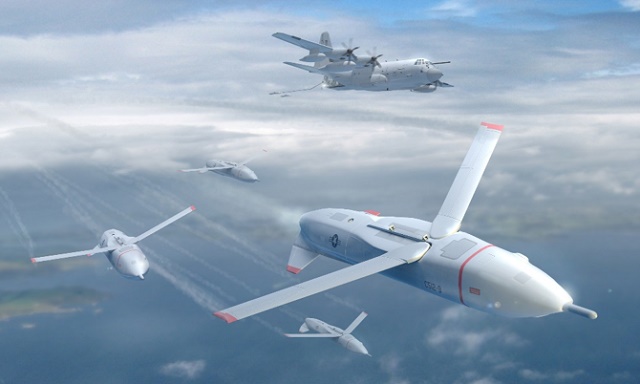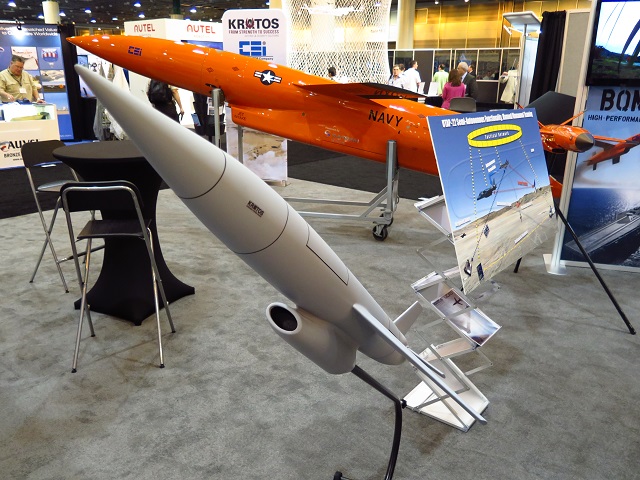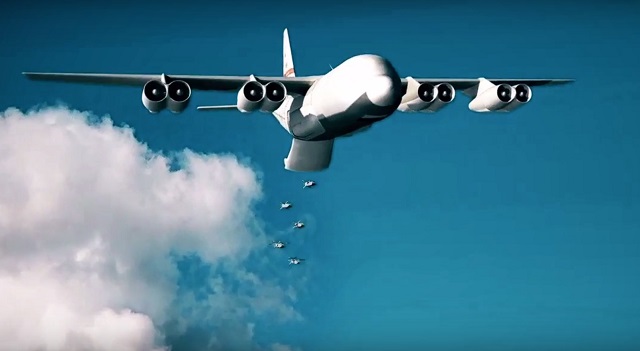As the United States continues its two flagship multi-billion acquisition programmes – the Lockheed Martin F-35 Joint Strike Fighter and the Northrop Grumman B-21 bomber – the Department of Defense’s research arms have their eye on cheaper, disposable drones that would overwhelm the enemy in contested environments.
Over the past year, the Defense Advanced Research Projects Agency (DARPA) and the Air Force Research Laboratory (AFRL) have advanced two emerging small UAV concepts: the low-cost, attritable strike UAS demonstration (LCASD) and a recoverable, swarming drone concept known as “Gremlins”. Both programmes focus on lowering the cost of the platform, but LCASD drones will be recovered on the ground while Gremlins will air launch from a variety of platforms before in-flight recovery by a Lockheed C-130.
Fleets of small UAVs have the potential to disrupt not only enemy air defences, but also the market for the costly and complex aircraft programmes beloved of aerospace prime contractors.
A 2015 proposers’ day notice for Gremlins states: “Instead of relying only on expensive, stealthy, penetrating, multi-function aircraft to execute critical functions such as electronic attack or target geolocation, larger numbers of much smaller but co-ordinated air-launched unmanned aircraft can be employed.”

Along with autonomy, robots and hypersonic propulsion, the idea of “swarming UAVs” has become one of the many buzzwords tossed around in the Defense Department’s third offset initiative.
But the US services have long used teams of recoverable drones, going back to the high-speed Ryan Aeronautical BQM-34F Firebee target drone of the Vietnam era. The air force would launch its BQM-34Fs from the ground or from a C-130. After performing its mission, the Firebee was often recovered with the mid-air retrieval system (MARS), in which a helicopter would snatch up the drone by its parachute.
Ryan Aeronautical’s drone compensated for its small size with its volume of orders. The USAF and US Navy bought thousands of the small target drones, using them for ISR missions, decoys and even leaflet drops, says Caitlin Lee, a political scientist at Rand Corporation focusing on air warfare and drone operations. That earlier victory for small UAVs could augur well for Gremlins or LCASD in the future, Lee says.
“Just because this project is small now and is resting with DARPA does not mean the company that wins a production contract won’t eventually be making a lot of money,” she says.
The USAF even references Ryan’s drone in its broad agency announcement for LCASD, saying its vision includes a concept that could include multiple variants acquired on a “routine” basis, like the Firebee. The service envisions a platform with a short life cycle that could be upgraded with new technologies without waiting for major system upgrade cycles, the document states.
The expendable LCASD drones would provide long-range, high-speed strike capability in remote areas where forward basing proves difficult, according to the document. An order of less than 100 UAVs would cost $3 million per copy, while a larger quantity should cost $2 million per copy, the USAF states.
In July, AFRL awarded Kratos Defense and Security Solutions a $40.8 million research and development contract for LCASD. The company, which already produces small target drones for the USAF and US Army, is also competing for the Gremlins contract against Dynetics, General Atomics Aeronautical Systems and Lockheed Martin.
The USAF has called for a 227kg (500lb) payload and Mach 0.9 speed for LCASD. Kratos is offering a 6.1m (20ft)-long and 3m-wide UAV, which would be bigger than the company’s largest target system, the BQM-167. Separately, the air force is searching for an engine for the LCASD. While Kratos will use an off-the-shelf turbofan for the demonstration, the company may choose a different option for the final engine.

The cheap UAVs provide an attractive option as possible “kamikaze drones” which could engage sophisticated integrated air defence systems. While the outline document states that the drone should be sized to carry at least two GBU-39 small-diameter bombs, there is no intention to drop a bomb from the LCASD, says Reid Melville, UAS strategy lead at AFRL’s aerospace systems directorate.
Before the USAF determines whether the UAVs will perform a strike or intelligence, surveillance and reconnaissance mission, the AFRL must prove the low-cost concept, Melville says.
“Both of these programmes are trying to address affordability and attacking it from two different directions,” he says. “The hard part of Gremlins is the aerial recovery of the UAS, as a way to get them to an affordable point. Whereas LCASD is looking at manufacturing and life-cycle costs so the platform itself is cheaper to acquire and cheaper to maintain so that we can operate it multiple times. Both are feeding off a need we have to find more affordable price points for delivering aerial combat capability for the air force.”
DARPA has pegged the per-unit price for Gremlins at $700,000 and the aerial recovery portion could save the services even more time and money. Rather than recovering from the ground, air recovery lends more flexibility and compensates for the limited range of small UASs.
But aerial recovery still poses several engineering hurdles, Melville says. Earlier concepts such as Firebee proved drones could be recovered in the air, but DARPA and the USAF are staring down new challenges with the size and scope of the Gremlins mission. The services envision a swarm of Gremlins flying at more than Mach 0.8 that must be recovered at a rate of four every 30min – particularly difficult in the turbulent airflow at the rear of a C-130.
“It’s unsteady and changes constantly,” Melville says. “When you open the ramp it’s the same thing, it’s even worse because there’s additional sources of rotational energy.”
Eric DeMarco, president and chief executive of Kratos, says the company’s Gremlins design will be based on a highly modified UTAP-22, its survivable, unmanned jet designed for hostile environments. Lockheed Martin, meanwhile, is developing technology for Gremlins based on its Joint Air-to-Surface Standoff Missile.
“It’s going to have to be configured differently and the design is going to have to be structurally different in order to be retrieved in the aircraft, given the significant turbulence either behind or under the plane as it’s being retrieved,” DeMarco says.
That wake issue may prove challenging for Kratos to overcome, but the company has already demonstrated the swarming portion of the Gremlins mission with a technology called Wolfpack. Kratos has demonstrated up to 20 UAVs flying together into contested and GPS-denied environments, DeMarco says. The company developed Wolfpack with internal funding and presented the technology as part of its Gremlins pitch.

“If one of the leaders gets taken out, the technology is such that any of the other ones can immediately take over and become the leader,” he says. “We’ve kept it in the dark, but it’s about ready for prime time.”
Wolfpack harkens back to the massed infantry attacks of the First World War, says Peter Singer, a strategist at the New America Foundation and the author of Ghost Fleet, a novel exploring future warfare.
“One of the appeals of a system like a Gremlin or swarm of drones, it’s not just that it’s disposable to send into dangerous areas because of human or financial loss,” he says. “But also it opens up new tactics or rather, it opens up old tactics.”
In the past, a Predator or Reaper saved the life of a pilot. But the disposable nature of small UAVs allows the enemy to see the aircraft and may even bait them to reveal their capabilities, according to Singer. Rather than equip a drone with stealth technology, the aircraft could fly directly into an anti-access area denial environment and expose the location of surface-to-air missiles.
Small UAVs could also squeeze through a gap in current defences, Caitlin Lee says. Typical air defence systems are not optimised to track small objects, such as birds and micro-UAVs, leaving a space for the drones to manoeuvre.
“The idea of developing a small drone that could penetrate any airspace unseen opens an entire new world of opportunity,” she says. “Because you’re not being seen, you have an opportunity to not only jam the radar, but maybe use something like an electromagnetic pulse to shut the radar down. Or third, maybe that drone has a munition on it and it makes a kinetic approach.”
Still, the small UAVs are not an immediate fix or replacement for larger drones. Swarming UAVs could include more communication points, which create more points of vulnerability, Singer says. In addition to their payload limitation, mission duration and low range, the military and defence industrial base must make the cultural pivot away from low- and slow-flying systems.
Source: FlightGlobal.com













































